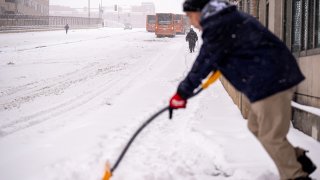
Heating bills are expected to rise again this winter, especially for those who warm their homes with electricity.
U.S. home heating costs are projected to climb 8.7% to an average of $941 for the season, according to the National Energy Assistance Directors Association, which represents state administrators of federal utility aid to low-income households.
The group said that’s largely due to the continued run-up in electricity prices coupled with forecasts for colder weather in the Midwest and Northeast. Already, parts of both regions are gripped by a winter storm that has killed at least four people, disrupted travel and knocked out power for hundreds of thousands of households.
People who heat their homes with electricity, rather than other common energy sources like natural gas, heating oil or propane, could see the biggest increases. Their bills are expected to swell by 14.2% to an average of $1,189, up from $1,040 last winter, NEADA said last month. Federal data shows electricity costs were up 3.1% in the 12-month period ending in November, higher than the overall 2.7% inflation rate.
“Families who just finished paying for record-high electric bills because of the extreme summer temperatures are now facing higher winter bills as well,” NEADA Executive Director Mark Wolfe said. “They’re getting hit on both sides.”
The federal Low Income Home Energy Assistance Program, which subsidizes utility costs for qualifying households, was allocated $3.7 billion as part of an appropriations bill President Joe Biden signed in September. That’s more than $2 billion short of the $6.1 billion LIHEAP officials have requested, which would bring the program’s funding back to its level for the 2023 fiscal year. The higher amount was partly thanks to a pandemic-era effort to provide additional relief to low-income households during the health crisis, but Wolfe sees it as the appropriate level going forward.
“I thought that with record summer temperatures, we had a pretty good case,” he said, adding that shifting weather patterns require a new standard. But so far policymakers haven’t granted advocates’ calls for a fresh influx.
U.S. & World
LIHEAP’s resources have been stretched thin by extreme heat as climate change fuels more scorching summertime weather. State groups that distribute the federal aid — which was originally meant to tackle winter heating costs — have struggled to meet higher demand for help covering air-conditioning bills, requiring them to decide how much to allocate in both seasons before their annual coffers run dry.
Under LIHEAP’s current funding levels, about 80% of the program’s aid goes toward winter heating costs and 20% toward summer cooling, Wolfe estimated. That has left little to help indebted households pay down their overdue bills.
Get a weekly recap of the latest San Francisco Bay Area housing news. >Sign up for NBC Bay Area’s Housing Deconstructed newsletter.
“Right now, the emphasis by the incoming Trump administration and the Republican Congress appears to be to cut funding levels for programs like LIHEAP, rather than increase them to meet changing needs,” Wolfe said. “If we do not receive additional funding, consumer debt levels will likely reach even higher levels.”
That could mean power shutoffs for many households and “tough choices of paying for their utility bills or food, medicine and other essentials,” he said.
President-elect Donald Trump’s transition team didn’t comment on LIHEAP funding but said the incoming administration would deliver on campaign promises to lower consumers’ energy costs. “When he takes office, President Trump will make America energy dominant again, protect our energy jobs, and bring down the cost of living for working families,” spokeswoman Karoline Leavitt said in a statement.
Already, NEADA estimates 1 in 6 households are behind on their utility bills. The total amount of money owed in arrears has swelled by roughly 30% over the past 12 months for electricity and natural gas customers, topping out around $21 billion by the end of September. NEADA attributes much of the debt increase to historically high home-cooling expenses over the summer.
Midwestern households are expected to see the biggest utility bill increases this winter, rising by 14.6% on average for all energy sources since last season, according to NEADA. Bills in the Northeast are set to rise less steeply, by 5.1%, while customers in the South and West should see the smallest upticks, at 1.6% and 3.2%, respectively.
Experts say there are a few ways consumers can hold down their heating costs. The website https://www.energystar.gov/saveathome includes a rebate finder to locate any savings local utility providers are offering. It also lists tax credits for energy-saving home improvements, including up to $3,200 for certain upgrades — like installing a heat pump or adding new windows or insulation — under Biden’s signature Inflation Reduction Act.
The Energy Department estimates that insulation improvements and sealing up leaks around doorframes, windows, ductwork and other areas where heat can escape can save 11% a year on home energy costs. It also recommends moving thermostats away from drafty windows or direct sunlight to ensure steady baseline temperatures and dialing them down by 7 to 10 degrees Fahrenheit when you’re asleep or away.
Agency officials point out that water heating is typically the second-largest energy expense, so set your water heater to 120 degrees — any higher could cost you up to several hundred extra dollars a year — and insulate any exposed hot water pipes with foam sleeves. If you have a dishwasher, consider skipping the drying cycle and letting your plates air-dry with the door ajar.
And for washing machines, water heating accounts for most of the system’s energy use. Just switching from the hot setting to warm can cut it in half.
This story first appeared on NBCNews.com. More from NBC News:



